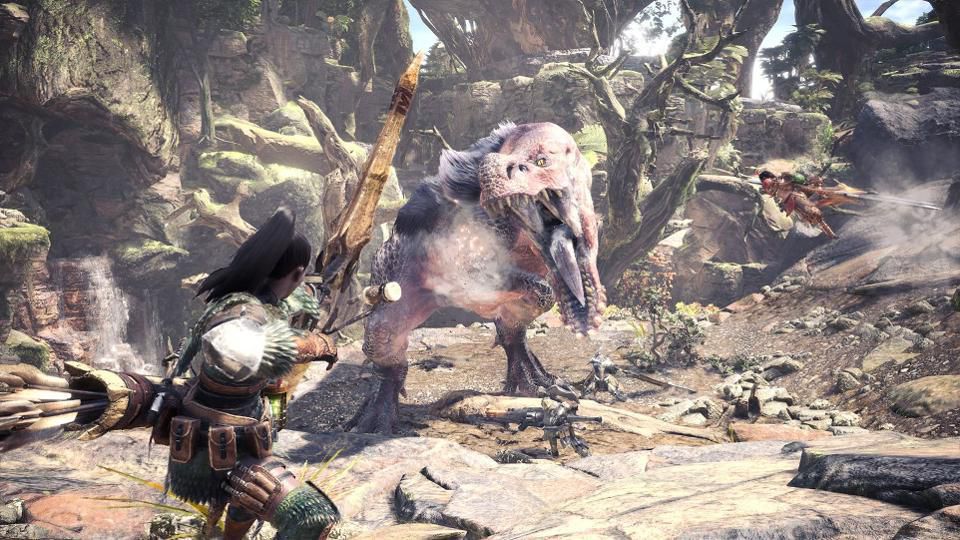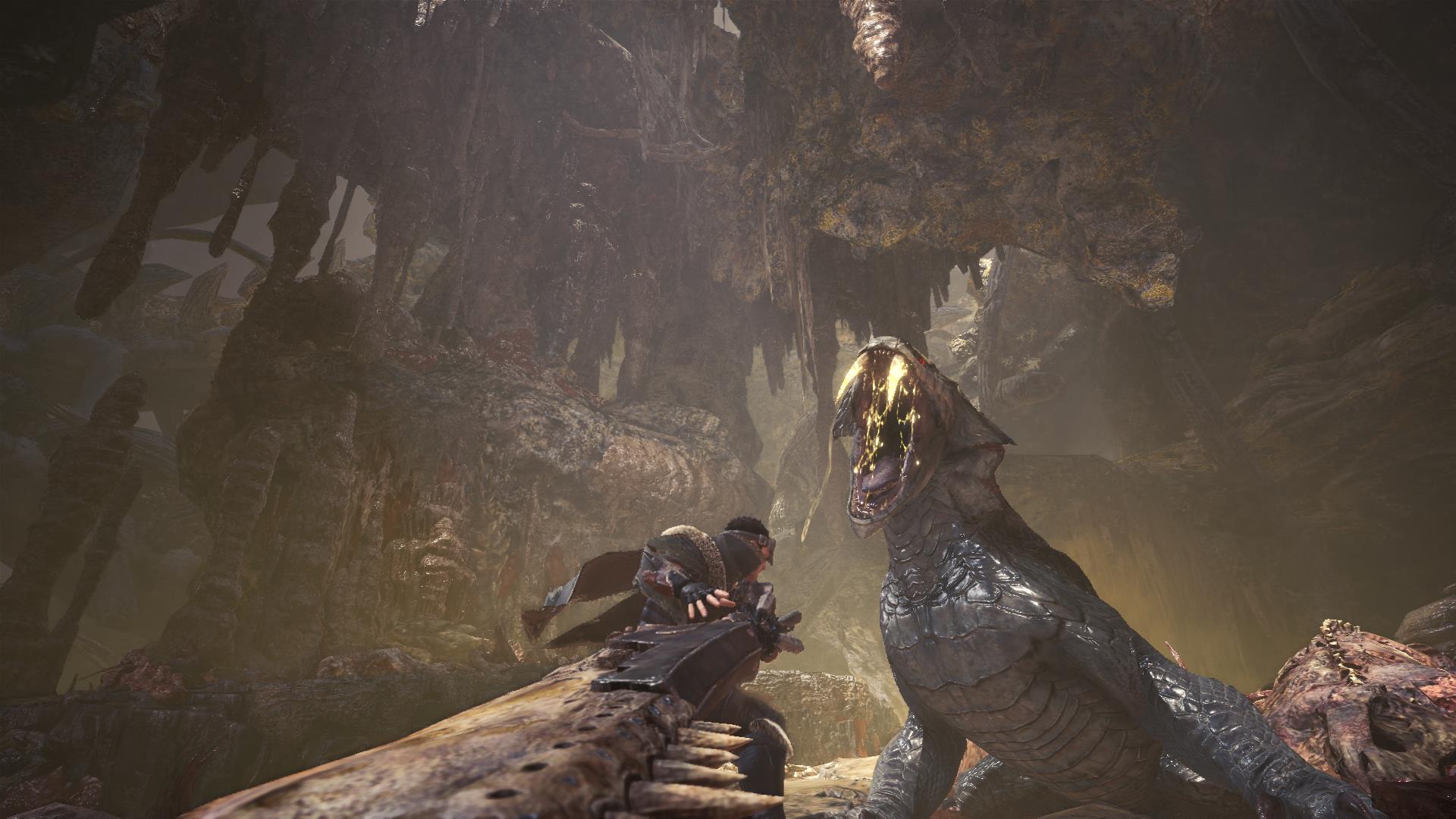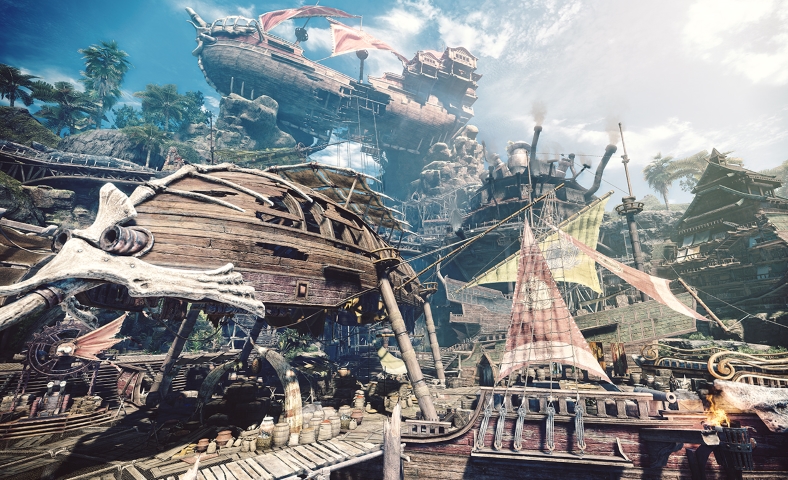We seem to be in an era of old franchises getting full remasters, and Monster Hunter: World is no exception. With video games and technology evolving at such a rapid rate, it’s only natural for established series to follow suit, after all, in order to keep up with the rest of the industry.
So the real question is, did Capcom manage to successfully reimagine Monster Hunter, or did it lose its identity along the way? Is it any good, does it have enough content, how does it stack up to previous entries, and is it worth your time?
Monster Hunter: World Review
But first, an introduction. Monster Hunter is a series all about, as it happens, hunting monsters. You pick up a quest in a HUB town, you go on a hunt to fight a large monster out in the wild over a prolonged period of time, you carve up your kill for crafting materials, and you craft better armor and weapons with it so you can go hunt bigger and tougher monsters.
It’s a simple formula, but it’s addicting, especially since the prolonged fights with monsters feel so organic and lively. And thankfully, that core is still here in World, even if they shook it up quite dramatically. I’d argue, however, that every change they made only serves to improve the core gameplay.
The Hunt
While the basics of hunting monsters are the same as they’ve always been, there’s been quite a number of alterations to the way it plays out and the options you have while out and about.
As you fly into base camp at the start of a quest, you’ll notice a few new things. First of all, there’s a tent, where you can access your item box and change your equipment. Then you’ll see a mini canteen that can seat up to four people where you can eat once every 10 minutes. On top of that, each map has at least two camps, and they can be fast-traveled to whenever you’re not in combat.
This is huge, too, since the maps are fairly large and open. No longer do you have to go through a loading screen and hunt each zone for a monster. Now you’re just roaming around one giant map, and traversing the entirety of it on foot is an adventure all on its own. I’m still discovering plenty of secrets to each of the five main maps over 90 hours into the game.
With maps so large, though, searching for monsters by just aimlessly wandering around wasn’t going to cut it in this title, so they added a new tracking system and scoutflies to guide the way. Once you’ve seen a monster or interacted with its tracks enough, you’ll know their location on the map for the rest of the hunt, saving you the embarrassment of losing your mark.
Fighting a monster is an experience all on its own. It basically revolves around studying a monster’s attack patterns and finding the openings where you can unleash hell on them using a variety of unique weapons. However, fights are so much more than just memorizing attack patterns. Monsters get angry, they get scared, and they get exhausted as if they were real creatures. They’re willing to eat or flee to their nests to sleep in order to regain their strength. They’ll even fight other monsters if they get in the way. It feels like you’re a part of a living, breathing ecosystem, and the gameplay only serves to accentuate that.
Once the monster is dead or captured, you’ll receive a bunch of materials from it that can then be used to craft new armor or upgrade your weapons. However, merely calling them materials doesn’t quite impress upon you exactly how important they are.
You’re Expected to Supply Everything Yourself
You’re expected to supply absolutely everything yourself. You won’t be receiving gear or items as quest rewards. Rather, you receive herbs, ores, bugs, bones, and monster parts used in crafting. If you’re running out of potions and traps, you’re going to need to craft more. If you want better equipment, you need to work for it.
Yes, that means you’ll sometimes find yourself grinding a monster for parts that you need. Yes, sometimes you’ll have to go on several dozen hunts to get that one rare item you need. However, while playing through a 15-minute hunt over and over again may sound tedious, I actually find every moment of it to be rather exciting, especially while playing with friends.
Besides that, there are plenty of new features in this installment to boost your luck with materials, and they aren’t even tied to microtransactions. For example, every day you receive a Lucky Voucher that can be used when accepting a quest to receive double the rewards on a mission. Then later on in the game, you can even receive a Palico Gadget specifically designed to gather extra materials from monsters.
Overall, I like the idea of supplying everything myself because it makes me feel like I’ve actually earned all of my accomplishments. I crafted the gear that helped me survive, I crafted the potions that I drink to heal, and I even crafted the flashpods and demonpowders I need to support and buff my party. I get to decide how prepared I am going into a fight, and all of my accomplishments are my own.
Progression and Story
Monster Hunter: World focuses more on story than MH games of yore, and unfortunately, it’s not that well executed. It’s an interesting way to learn about monster lore; however, the plot is bland, and characters don’t tend to react to things in a very natural way. But that’s okay. This series was never known for its storytelling, and it’s not about to start to be now.
Rather than actually being something to get invested in, the story is merely a means to an end. It’s meant to propel you through the game and help you progress, which is leagues better than simply receiving several quests at a time with no clue on which ones are needed for progression. (Yeah, that was actually how we had to progress in past games — it was a trip.)
Progressing largely revolves around fighting monsters, using their materials to craft armor and weapons, and fighting stronger monsters. However, as you progress through the main missions, you’ll slowly unlock special features that layer onto existing features and make the game deeper and deeper. For example, you’ll eventually unlock a farm where you can essentially duplicate certain kinds of herbs, mushrooms, and bugs.
As you progress through the story, you’ll even unlock upgrades for all sorts of facilities in the main HUB town, including new items for the Provisions Stockpile, new ingredients for the Canteen, and new Hunter Tools for your ever-growing arsenal. You’ll even unlock bigger houses with more room for placing all the Endemic Life you captured as pets.
Eventually, you’ll beat something that resembles a final boss, and you’ll probably think to yourself, “That was it? I could have sworn everyone said this game was longer than that.” In truth, though, that’s because that’s not it, and it is longer. You just entered a new mode called High Rank, where old monsters are stronger, you can craft all sorts of new things, and there are a plethora of new threats roaming the land.
Rather than simply throwing you into the thick of things, though, the game brilliantly adds a bit of padding to the main quest during the transitional stage in order to encourage players to fight the High Rank monsters, make new gear, and prepare for the challenges to come.
Now I’m over 90 hours into the game, and I am not quite done with High Rank yet, but I’ve heard from several sources that there is still plenty of content left after beating the final boss. Suffice it to say, I’m extremely excited to continue playing and see what awaits me in the endgame.
Multiplayer
One of the biggest draws to this game is being able to play almost every single quest with your friends. Up to four people can band together to hunt a monster, and up to sixteen hunters can gather in the same multiplayer lobby together. You can even create a Squad with an emblem and everything and invite up to 50 people so you can all hunt together whenever you want. You can join up to eight squads, so you don’t have to worry about dedicating yourself to just one.
The main story quests force you to start solo until you’ve seen all the cut-scenes; however, this is essentially not an issue since anyone in your lobby can just drop into your quest mid-hunt now so long as there’s room in your party. And if you require assistance, you can even fire an SOS in order to open up your quest to random players outside of your lobby.
The great multiplayer improvements, combined with communication features like voice chat, stickers, and gestures, really round it out as an incredible multiplayer experience.
Verdict
Monster Hunter: World is an absolutely brilliant reimagining of an already-adored franchise. It improves on every aspect of past games and even fixes most — if not all — of my major gripes with the series. It may just be a silly game about hunting monsters, but it’s so well refined and put together that it’s honestly a hard title to ignore.
If you’re a newcomer looking to get into the series, this is the game you want. If you’re a veteran looking to get back into it, trust me when I say you won’t be disappointed here. And if you’re one of those people who has tried several times to get into the series but just can’t for some reason, I highly encourage you to try again with this entry. It really is just that much better.
Monster Hunter: World is available now for $60 on PS4 and Xbox One, with a PC version planned for release in Autumn.











Published: Feb 2, 2018 01:59 am